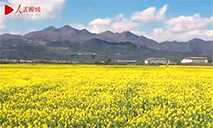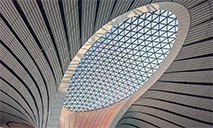Legacy of Beijing Winter Olympics through architects' eyes
* In the magnificent and dazzling Olympic spaces, we get to know more about ourselves, make our dreams come true and enjoy the feeling of interdependence. We also find a model for smart cities and low-carbon life in the future.
* Sports and architecture both encourage people to find their better selves. I hope we can bring the energy of working for the Beijing Winter Olympics into future projects and mobilize more people to find their better selves in city life.
* Every participant in venue design, construction and organization for the Games is a valuable part of the Olympic legacy. We try to record our experiences for the benefits of the future generations and solve the present problems with a mindset of looking into the future.
BEIJING, March 26 (Xinhua) -- Athletes and spectators worldwide have been amazed by the various competition venues of the Beijing Winter Olympics, with their distinctive designs and features. Now the buildings are about to open to the public and will perform a new role, demonstrating China's aspirations for a sustainable future.
"The legacy of the Beijing Winter Olympics can be described in just one word, which is 'sustainability'," said Zhang Li, architect-in-chief of the Zhangjiakou competition zone and Big Air Shougang, hailing a range of unique solutions, such as combining the needs of the athletes and citizens, and promoting ecological reclamation and urban transformation.
OLYMPIC LEGEND GOES ON
With its elegant shape and ice smooth as a mirror, the National Speed Skating Oval in Beijing is widely known as the "Ice Ribbon." It has witnessed around a dozen of Olympic and world records broken at the venue during the Beijing Winter Olympics.

Zheng Fang, the oval's principal architect, still remembers how excited he was when he noticed that the transparent exterior looked like ribbons of ice covering the venue when he created the concept sketches in 2016.
"At that moment, I decided to name it 'Ice Ribbon', and I believe people will like it and hope it will be known all over the world," he said.
Canadian speed skater Isabelle Weidemann was also impressed, commenting, "Absolutely, it's a beautiful oval. I think we're happy to be here. We're so excited to be racing."
In the post-Olympic time, the venue will stay to tell Beijing's legendary accomplishment as the only dual Olympic city in the world.
In the near future, it will become a large-scale ice-sports center open to the public in all seasons, as well as being a venue for international events. The vast expanse of ice, which is about 12,000 square meters, can accommodate a wide range of sports, such as speed skating, figure skating and curling.

Photo taken on Jan. 22, 2021 shows the interior view of the National Speed Skating Oval in Beijing, capital of China. (Xinhua/Ju Huanzong)
As with various other Beijing Winter Olympic venues, sustainability is a key element of the "Ice Ribbon"'s design. It has a "light-weight roof" composed of an innovative cable-net structure, an intelligent system controlling the interior environment and uses carbon dioxide refrigerant to improve the quality of the ice and reduce energy consumption.
Another example of the same principle is the National Ski Jumping Center, located in the Zhangjiakou competition zone. Its design follows a smooth curve, supported by pillars, leaving space for animal migration and protecting the mountain's water and plant systems.
It is nicknamed "Snow Ruyi" because its shape resembles a Ruyi, an ornament symbolizing good luck in traditional Chinese culture.
In designing the venue, Zhang Li's team combined traditional Chinese culture with the idea of green development, to ensure it is fit for indoor and outdoor activities after the Games.
The disc-shaped structure at the top can accommodate nearly 1,000 people, and can be used for exhibitions and ceremonies, as well as for sightseeing or viewing games. The football field down below can host opening ceremonies for cultural events and concerts. Visitors can also climb the stairs along the slope to view the nearby mountains and rivers.

Photo taken on Oct. 23, 2021 shows the National Ski Jumping Center in Zhangjiakou, north China's Hebei Province. (Xinhua/Yang Shiyao)
At the Yanqing competition zone located the National Sliding Center -- nicknamed "Snow Dragon" for its winding track with a huge spiral curve in the middle. Athletes described the venue as being "in a class of its own."
According to Zhang Yuting, associate design principal of the "Snow Dragon," rather than being deliberately planned, the spiral was designed after several revisions based on the terrain of the mountain, integrating the architecture into the surrounding environment, while special features were included for post-Games utilization.
When it opens to the public in May, people will be able to slide down from the start point reserved for public use and enjoy the thrill of a part of the track, as well as walking along the rooftop promenade to enjoy the natural scenery. A start house has been specially built for junior athletes, allowing the venue to become a training base for future athletes.

"On the last competition day of the Winter Olympics, all the memories lingered in my mind, and I shed silent tears. Like our track, we wind all the way to the finish line. And the end is also the beginning," Zhang Yuting said.
BEYOND SPORTS VENUES
Architects say that building the Olympic venues has propelled the construction of railways, expressways and renewable-energy networks, leaving a wealth of infrastructure for regional development. The heritage of the Games is also expected to bring people together for a better life.
Roberto Moresi from the International Ski Federation visited the Big Air Shougang while it was under construction. As Zhang Li recalled, Moresi was impressed to see the world's first permanent big air venue for long-term usage, and said it felt to him like "an Asian home" for the sport.
"You don't need to be an architect to get the weight of the word 'home'. Only when a place offers a sense of belonging and a source of affection can it be called a 'home'," Zhang said.

Zheng Fang holds the same view on the importance of Olympic architecture for humanity. "In the magnificent and dazzling Olympic spaces, we get to know more about ourselves, make our dreams come true and enjoy the feeling of interdependence. We also find a model for smart cities and low-carbon life in the future," he said.
Green and low-carbon technological innovations have not only addressed environmental problems, but also cultivated new architectural spaces and lifestyles, Zheng said, anticipating future opportunities in the fields of green architecture, low-carbon community and intelligent city systems.
"Sports and architecture both encourage people to find their better selves. I hope we can bring the energy of working for the Beijing Winter Olympics into future projects and mobilize more people to find their better selves in city life," Zhang Li said.

Inspired by the Beijing Winter Olympics, those designing China's domestic engineering projects have attached more importance to the sustainability of the environment and economic and social development, said Li Xinggang, chief planner and design principal of the Yanqing competition zone and its venues.
"Every participant in venue design, construction and organization for the Games is a valuable part of the Olympic legacy. We try to record our experiences for the benefits of the future generations and solve the present problems with a mindset of looking into the future," he said.
Photos
 Increasingly more young adults in China register wills that include virtual assets
Increasingly more young adults in China register wills that include virtual assets Rapeseed flowers turn NW China's Luoping into picturesque spring wonderland
Rapeseed flowers turn NW China's Luoping into picturesque spring wonderland Why do people in China fall for animated characters like LinaBell and Bing Dwen Dwen?
Why do people in China fall for animated characters like LinaBell and Bing Dwen Dwen? Photo Album: architecture in Beijing merging history and modernity
Photo Album: architecture in Beijing merging history and modernity
Related Stories
- Beijing 2022 cloud technology sets new bar for Olympic Games, says IOC official
- Chinese consul-general in Perth publishes signed article entitled “Unite under the Olympic Spirit”
- Interview: Argentine Paralympic athlete stresses healing power of sports
- Beijing Olympic Village to reopen as shopping park in September
- Interview: Mongolian Paralympic official hails organization of Beijing 2022
Copyright © 2022 People's Daily Online. All Rights Reserved.






